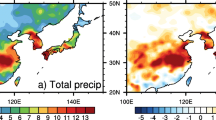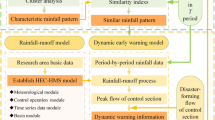Abstract
Floods are recurring phenomena at certain locations because of excessive rainfall, resulting in the overflow of lakes, drains, and rivers. In this work, we employ Persistence Homology (PH) to investigate the relationship between rainfall and flood that occurred from 1997 to 2018. Three stations in Kemaman, Terengganu, have been chosen to study this relationship. Persistence Diagram (PD) is one of the most powerful tools available under the umbrella of PH for detecting topological signatures in high dimension points cloud. In this paper, we use the rainfall time series dataset and express it in higher dimensions by selecting the embedded dimension, \(M = 5\), , and manipulating the time delay τ to obtain the maximum persistence. Then, we compared with past flood events which are labelled based on water level and PD’s max score to identify its suitability for flood identification. The area under the curve of receiver operation characteristics (ROC) have been used to measure the performance with three different thresholds for station 4131001, 4232002, and 4332001. The results clearly show PD’s significance to characterize the rainfall dataset as normal and flood events. The employed maximum persistence is robust despite missing data values.
Access this chapter
Tax calculation will be finalised at checkout
Purchases are for personal use only
Similar content being viewed by others
References
Gullick, J.M.: Old Kuala Lumpur. Oxford Univ Press, New York (1994)
Kelantan Flood Report. Drainage and Irrigation Department Kelantan (1967)
Syamimi, I.N., Azharudin, M.D., Rodzi, A.R.M.: Sejarah banjir besar di semenanjung malaysia, 1926–1971. J. Perspekt. 6(3), 54–67 (2014)
Eliza, N., Mohamad, H., Yoke, W., Yusop, Z.: Rainfall analysis of the Kelantan big yellow flood 2014. J. Teknol. 4, 83–90 (2016)
Akasah, Z.A., Doraisamy, S.V.: 2014 Malaysia flood: impacts & factors contributing towards the restoration of damages. J. Sci. Res. Dev. 2(14), 53–59 (2015)
Muhammad, N.S., Abdullah, J., Julien, P.Y.: Characteristics of rainfall in peninsular Malaysia. J. Phys. Conf. Ser. 1529(5) (2020)
Carlsson, G.: Topology and data 46(2) (2009)
Munkres, J.R.: Elements of Algebraic Topology. Addison Wesley (1993)
Gidea, M., Katz, Y.: Topological data analysis of financial time series: landscapes of crashes. Phys. A Stat. Mech. its Appl. 491, 820–834 (2018)
Gidea, M., Goldsmith, D., Katz, Y., Roldan, P., Shmalo, Y.: Topological recognition of critical transitions in time series of cryptocurrencies. Phys. A Stat. Mech. its Appl. 123843 (2020)
Yen, P.T.W., Cheong, S.A.: Using topological data analysis (TDA) and persistent homology to analyze the stock markets in Singapore and Taiwan. Front. Phys. 9(March), 1–19 (2021)
Yen, P.T., Xia, K.: Understanding changes in the topology and geometry of financial market correlations during a market crash 1–48 (2021)
Katz, Y.A., Biem, A.: Time-resolved topological data analysis of market instabilities. Phys. A Stat. Mech. its Appl. 571, 125816 (2021)
Zulkepli, N.F.S., Noorani, M.S.M., Razak, F.A., Ismail, M., Alias, M.A.: Topological characterization of haze episodes using persistent homology. Aerosol Air Qual. Res. 19(7), 1614–1621 (2019)
Musa, S.M.S.S., Md Nooran, M.S., Razak, F.A., Ismail, M., Alias, M.A., Hussain, S.I.: Using persistent homology as preprocessing of early warning signals for critical transition in flood. Sci. Rep. 11(1), 1–14 (2021). https://doi.org/10.1038/s41598-021-86739-5
Gobithaasan, R.U., et al.: Clustering selected terengganu’s rainfall stations based on persistent homology. Thai J. Math. 2022(Special Issue), 197–211 (2022)
Tralie, C.J., Perea, J.A.: (Quasi)periodicity quantification in video data, using topology. SIAM J. Imaging Sci. 11(2), 1049–1077 (2018)
Perea, J.A., Deckard, A., Haase, S.B., Harer, J.: SW1PerS: Sliding windows and 1-persistence scoring; discovering periodicity in gene expression time series data. BMC Bioinform. 16(1), 1–12 (2015)
Myers, A., Munch, E., Khasawneh, F.A.: Persistent homology of complex networks for dynamic state detection. Phys. Rev. E 100(2) (2019)
Soliman, M., Lyubchich, V., Gel, Y.R.: Ensemble forecasting of the Zika space-time spread with topological data analysis. Environmetrics 31(7), 1–13 (2020)
Yamanashi, T., et al.: Topological data analysis (TDA) enhances bispectral EEG (BSEEG) algorithm for detection of delirium. Sci. Rep. 11(1), 1–9 (2021)
Graff, G., Graff, B., Pilarczyk, P., Jabłoński, G., Gąsecki, D., Narkiewicz, K.: Persistent homology as a new method of the assessment of heart rate variability. PLoS One 16(7), e0253851 (2021). https://doi.org/10.1371/journal.pone.0253851
Edelsbrunner, H., Harer, J.: Computational Topology. Open Probl. Topol. II, 493–545 (2010)
Zomorodian, A., Carlsson, G.: Computing persistent homology. Proc. Annu. Symp. Comput. Geom. 347–356 (2004)
Perea, J.A., Harer, J.: Sliding windows and persistence: an application of topological methods to signal analysis. Found. Comput. Math. 15(3), 799–838 (2015). https://doi.org/10.1007/s10208-014-9206-z
Christopher, T., Nathaniel, S., Rann, B.-O.: A lean persistent homology library for python. Open J. 925 (2018)
Lim, K.Y., Zakaria, N.A., Foo, K.Y.: A shared vision on the historical flood events in Malaysia: integrated assessment of water quality and microbial variability. Disaster Adv. 12(8), 11–20 (2019)
Lum, P.Y., et al.: Extracting insights from the shape of complex data using topology. Sci. Rep. 3, 1–8 (2013)
Vietoris, L.: Über den höheren zusammenhang kompakter räume und eine klasse von zusammenhangstreuen abbildungen. Math. Ann. 97(1), 454–472 (1927)
Perea, J.A., An application of topological methods to signal 1(919), 1–34 (2013)
Vejdemo-Johansson, M., Skraba, P., De Silva, V.: Topological analysis of recurrent systems. Work. Algebr. Topol. Mach. Learn. NIPS 2(1), 2–6 (2012)
Takens, F.: Detecting strange attractors in turbulence. In: Rand, D., Young, L.-S. (eds.) Dynamical systems and Turbulence, Warwick 1980, pp. 366–381. Springer Berlin Heidelberg, Berlin, Heidelberg (1981). https://doi.org/10.1007/BFb0091924
Abdi, H., Williams, L.J.: Principal component analysis. Wiley Interdiscip. Rev. Comput. Stat. 2(4), 433–459 (2010)
Edelsbrunner, H., Letscher, D., Zomorodian, A.: Topological persistence and simplification. Discret. Comput. Geom. 28(4), 511–533 (2002)
Carlsson, G., Zomorodian, A., Collins, A., Guibas, L.J.: Persistence barcodes for shapes. Int. J. Shape Model. 11(2), 149–187 (2005)
Baldi, P., Brunak, S., Chauvin, Y., Andersen, C.A.F., Nielsen, H.: Assessing the accuracy of prediction algorithms for classification: an overview. Bioinformatics 16(5), 412–424 (2000)
Hanley, J.A., McNeil, B.J.: The meaning and use of the area under a receiver operating characteristic (ROC) curve. Radiology 143(1), 29–36 (1982)
Acknowledgments
This work was supported by the Ministry of Education Malaysia grant FRGS/1/2019/STG06/UMT/02/2. The authors also acknowledge Department of Irrigation and Drainage Malaysia for providing the rainfall and water level data.
Author information
Authors and Affiliations
Corresponding author
Editor information
Editors and Affiliations
Rights and permissions
Copyright information
© 2023 The Author(s), under exclusive license to Springer Nature Singapore Pte Ltd.
About this paper
Cite this paper
Hasan, Z.A., Gobithaasan, R.U. (2023). The Characterization of Rainfall Data Set Using Persistence Diagram and Its Relation to Extreme Events: Case Study of Three Locations in Kemaman, Terengganu. In: Yusoff, M., Hai, T., Kassim, M., Mohamed, A., Kita, E. (eds) Soft Computing in Data Science. SCDS 2023. Communications in Computer and Information Science, vol 1771. Springer, Singapore. https://doi.org/10.1007/978-981-99-0405-1_19
Download citation
DOI: https://doi.org/10.1007/978-981-99-0405-1_19
Published:
Publisher Name: Springer, Singapore
Print ISBN: 978-981-99-0404-4
Online ISBN: 978-981-99-0405-1
eBook Packages: Computer ScienceComputer Science (R0)




